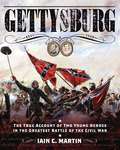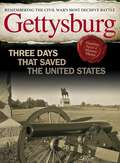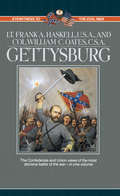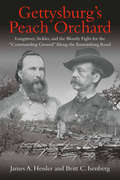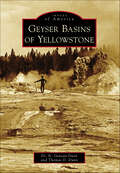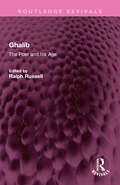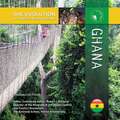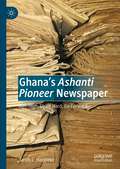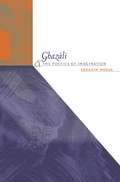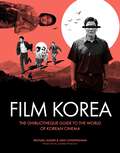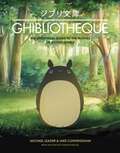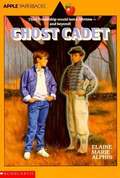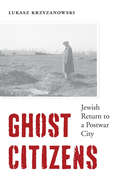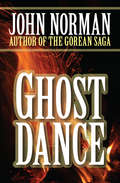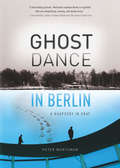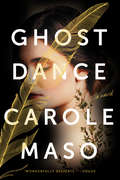- Table View
- List View
Gettysburg: The True Account of Two Young Heroes in the Greatest Battle of the Civil War
by Iain C. MartinIn the summer of 1863, General Robert E. Lee and the Army of Northern Virginia advanced into Pennsylvania in a daring offensive to win the Civil War in a single campaign. They met the Union Army at a quiet crossroads town called Gettysburg, and engaged in the greatest battle ever fought on American soil. Three days of combat ended on July 3 with Pickett's Charge, a heroic assault by nine of Lee's brigades against the Union defenses on Cemetery Ridge. Their repulse at the stone wall became known as the "high-water mark" of the Confederacy. At the dedication of the Soldiers' National Cemetery that November, Lincoln used the occasion to deliver his Gettysburg Address, a short, two-minute speech that became the most famous in American history.In this original retelling of the Gettysburg story, Iain C. Martin draws upon firsthand accounts--from the generals to the lowly privates and civilians caught in the epic struggle. Readers will discover history through the experiences of two Gettysburg teenagers--Matilda "Tillie" Pierce and Daniel Skelly. Featuring the artwork of Don Troiani, original photos, full-color maps, interesting tales, and trivia, Gettysburg gives young readers a fascinating look into this great turning point of American history--and just in time for the 150th anniversary of the epic battle.
Gettysburg: Three Days That Saved the United States
by Ben NussbaumRegarded as the turning point of the American Civil War, Gettysburg commemorates a three-day battle that took place in an "unimportant" Pennsylvania town over one hundred and fifty years ago. From the first shots fired at 7:30 a.m. on July 1, 1863 in a field west of Gettysburg, along the Chambersburg Pike, to Robert E. Lee's losing gamble known as Pickett's Charge on July 3, just fifty-five hours later, resulting in thousands of Confederates being driven back by Union forces, Gettysburg is a snapshot of three of the most important days in US history. Editor Ben Nussbaum has compiled a fascinating retelling of political, military, and social conditions that thrust the sleepy town of Gettysburg forever into the pages of history books. In addition to informative timelines and fact sheets of the battle of Gettysburg and the Civil War, this handsomely illustrated volume also captures the human stories-not just President Abraham Lincoln's famous address and the accounts of his involvement from afar but also the stories of Father Corby and the Irish Brigade; Amos Humiston, the unidentified father who died in battle clutching a photograph of his three children; the eleven-year-old sergeant, John L. Clem, who killed a Confederate soldier; John Burns, the only civilian to fight in the battle; and Jubal Early, an unlikely general who "scared Abraham Lincoln like hell." The chapter "The Reconciliation Reunion" is particularly poignant as the nation commemorated the one hundred and fiftieth anniversary of the Civil War in 2013. It tells of a reunion of 50,000 Union and Confederate veterans-eerily the same number of men who fell in the three-day battle-who traveled to Gettysburg in 1913 to mark the fiftieth anniversary of the conflict. The youngest man at the reunion was the 61-year-old John Lincoln Clem, the oldest Micyah Weiss, purportedly 112 years old. The accounts and photographs of their reconciliation remain moving one hundred years later and speak to a healing that was unthinkable in 1863. That the town of Gettysburg continues to be a destination for historians, Civil War reenactors, and tourists is a tribute to the continued battlefield preservation that has reshaped the town. Gettysburg boasts 148 historic buildings and 1320 monuments and memorials, not to mention 410 cannons and over 815 acres of sanctified battleground. In the chapter "Monumental Fields," Nussbaum salutes a dozen remarkable monuments, including the Virginia State Memorial, High Water Mark of Confederacy, the 20th Massachusetts Infantry, and the John Burns Statue. A resource section offers readers ways to learn more about the Battle of Gettysburg, including books, websites, and games.
Gettysburg: Three Days That Saved the United States
by Ben NussbaumPacked with facts, stories, and illustrations, a guide to the historic Pennsylvania battle that marked a turning point in the American Civil War. From the first shots fired at 7:30 a.m. on July 1, 1863 in a field west of Gettysburg to Robert E. Lee&’s losing gamble known as Pickett&’s Charge on July 3, just fifty-five hours later, Gettysburg is a snapshot of three of the most important days in US history. Editor Ben Nussbaum has compiled a fascinating retelling of political, military, and social conditions that thrust the sleepy town of Gettysburg forever into the pages of history books. In addition to informative timelines and fact sheets of the battle of Gettysburg and the Civil War, this handsomely illustrated volume also captures the human stories—of Father Corby and the Irish Brigade; Amos Humiston, the unidentified father who died in battle clutching a photograph of his three children; the eleven-year-old sergeant, John L. Clem, who killed a Confederate soldier; John Burns, the only civilian to fight in the battle; and Jubal Early, an unlikely general who &“scared Abraham Lincoln like hell.&” Also included is the poignant story and photographs of a reunion fifty years later of fifty thousand Union and Confederate veterans, among them a man believed to be 112 years old, and a chapter focusing on a dozen significant monuments among Gettysburg&’s numerous historic landmarks. In addition, a resource section offers readers and visitors ways to learn more about the Battle of Gettysburg, including books, websites, and games.
Gettysburg: Two Eyewitness Accounts (Eyewitness to the Civil War)
by Frank Haskell William C. OatesIn this unique series the Civil War comes vividly to life. Here an eyewitness accounts--many available for the first time in decades--by generals, journalist, and ordinary foot soldiers, both blue and gray, who relive the conflict in all its terrible glory. Each volume brings you a human perspective on the war--its most decisive battles, its most remarkable personalities. Gettysburg: Two Eyewitness Accounts is American history at its finest--and a reading experience you will never forget. In some ways it epitomized the entire war: three hot days in July filled with missed opportunities, great courage, inconsistent leadership, and horrific, relentless carnage. In rare volume we see the battle from both sides, as experienced by two very different combatants, one Union and the other Confederate. From Little Round Top to Devil's Den to Pickett's Charge, Lt. Frank A. Haskell and Col. William C. Oates, one in a meticulous hindsight and the other still feverish with war, re-create three days that changed American history. Here are the momentous decisions of Lee, Longstreet, and Meade. Here are the fatal maneuverings of the forces in the field. And here, in descriptions unmatched in Civil War literature, is all the heartbreak and triumph of Gettysburg.From the Paperback edition.
Gettysburg’s Peach Orchard: Longstreet, Sickles, and the Bloody Fight for the “Commanding Ground” Along the Emmitsburg Road
by James A. Hessler Britt C. IsenbergWinner, 2019, The Bachelder-Coddington Literary Award, Given by the Robert E. Lee Civil War Round Table of Central New Jersey More books have been written about the battle of Gettysburg than any other engagement of the Civil War. The historiography of the battle’s second day is usually dominated by the Union’s successful defense of Little Round Top, but the day’s most influential action occurred nearly one mile west along the Emmitsburg Road in farmer Joseph Sherfy’s peach orchard. Despite its overriding importance, no full-length study of this pivotal action has been written until now. James Hessler’s and Britt Isenberg’s Gettysburg’s Peach Orchard: Longstreet, Sickles, and the Bloody Fight for the “Commanding Ground” Along the Emmitsburg Road corrects that oversight. On July 2, 1863, Confederate Gen. Robert E. Lee ordered skeptical subordinate Lt. Gen. James Longstreet to launch a massive assault against the Union left flank. The offensive was intended to seize the Peach Orchard and surrounding ground along the Emmitsburg Road for use as an artillery position to support the ongoing attack. However, Union Maj. Gen. Daniel Sickles, a scheming former congressman from New York, misinterpreted his orders and occupied the orchard first. What followed was some of Gettysburg’s bloodiest and most controversial fighting. General Sickles’s questionable advance forced Longstreet’s artillery and infantry to fight for every inch of ground to Cemetery Ridge. The Confederate attack crushed the Peach Orchard salient and other parts of the Union line, threatening the left flank of Maj. Gen. George Meade’s army. The command decisions made in and around the Sherfy property influenced actions on every part of the battlefield. The occupation of the high ground at the Peach Orchard helped General Lee rationalize ordering the tragic July 3 assault known as “Pickett’s Charge.” This richly detailed study is based upon scores of primary accounts and a deep understanding of the terrain. Hessler and Isenberg, both Gettysburg Licensed Battlefield Guides, combine the military aspects of the fighting with human interest stories in a balanced treatment of the bloody attack and defense of Gettysburg’s Peach Orchard.
Gewalt in den Anden: Systemtheoretische Überlegungen zu Gewaltstrukturen in Kolumbien (Innovative Konfliktforschung – Innovation in Conflict Research)
by Bettina M.E. BenzingDas Buch beschäftigt sich mit den langfristigen sozialstrukturellen Auswirkungen von Gewaltkonflikten in Postkonfliktgesellschaften, eines der aktuellsten Forschungsthemen der Friedens- und Konfliktforschung. Basierend auf empirischer Forschung in verschiedenen Landesteilen Kolumbiens wird argumentiert, dass sich die unter Gewalteinfluss entstandenen Sozialstrukturen primär durch Misstrauensmechanismen in der Gesellschaft auszeichnen, wodurch sich einerseits Gewalt als Kommunikationsmuster auch nach Friedensschlüssen weiter erhält und reproduziert sowie andererseits sich exkludierende Strukturen für marginalisierte Bevölkerungsteile ausbilden, die einem Frieden nachhaltig entgegenwirken. Mittels eines systemtheoretischen Ansatzes macht das Buch daher ein Angebot zum besseren Verständnis anhaltender Gewalt in Postkonfliktgesellschaften.
Geyser Basins of Yellowstone
by Thomas D. Dunn N. Genean DunnYellowstone National Park contains over half the world�s active geysers, with more than 700 within its 3,472 square miles. The most famous geyser is Old Faithful, named in 1870 during the Washburn-Langford-Doane Expedition. In 1871, the US Geological and Geographical Survey, led by Dr. F.V. Hayden, reached the Upper Geyser Basin. In just over a day, the explorers witnessed eruptions of many geysers still seen today, including Giantess, Beehive, Grotto, Castle, and Old Faithful. Yellowstone became the first National Park in 1872. Since then, visitors have come in increasing numbers to witness the unique geysers, numerous wildlife, and spectacular scenery.
Ghalib: The Poet and his Age (Routledge Revivals)
by Ralph RussellFirst published in 1972, Ghalib presents aspects of Ghalib, the last great literary figured produced by Mughal India before the empire was swept away by the British after the Revolt of 1857, as he appears though the eyes of well-known British and other European scholars. The book gives a picture of Ghalib’s own personality as it emerges in passages from his own Persian and Urdu letters and prose writings. Percival Spear, who lived in Delhi for many years, describes the Delhi scene of Ghalib’s day. P. Hardy writes of his relations with the British, and finally, two essays, by A. Bausani and Ralph Russell respectively, give an account of his Persian and Urdu poetry. His book will be of interest to students of literature, poetry, South Asian studies and history.
Ghana (The Evolution of Africa's Major Nations)
by Barbara Aoki PoissonGhana, located on the Atlantic coast of West Africa, was once known as the Gold Coast because of its vast deposits of this precious mineral. In the 14th and 15th centuries Ghana was the home of powerful African kingdoms that traded both gold and slaves. Ghana's wealth attracted Europeans, and the British eventually incorporated the land into their empire. In 1957 Ghana became one of the first African countries to win independence--an event that inspired nationalist movements throughout the rest of the continent. Although most of Ghana's history as an independent nation has been marked by political strife, the situation seems to be improving. The country is now considered to be a stable democracy, as government power has been peacefully transferred several times since 2001.
Ghana on the Go: African Mobility in the Age of Motor Transportation
by Jennifer HartAs early as the 1910s, African drivers in colonial Ghana understood the possibilities that using imported motor transport could further the social and economic agendas of a diverse array of local agents, including chiefs, farmers, traders, fishermen, and urban workers. Jennifer Hart's powerful narrative of auto-mobility shows how drivers built on old trade routes to increase the speed and scale of motorized travel. Hart reveals that new forms of labor migration, economic enterprise, cultural production, and social practice were defined by autonomy and mobility and thus shaped the practices and values that formed the foundations of Ghanaian society today. Focusing on the everyday lives of individuals who participated in this century of social, cultural, and technological change, Hart comes to a more sensitive understanding of the ways in which these individuals made new technology meaningful to their local communities and associated it with their future aspirations.
Ghana’s Ashanti Pioneer Newspaper: Aim High, Strive Hard, Go Forward
by Jarvis L. HargroveThis book is a history of a prominent Ghanaian newspaper, the Ashanti Pioneer, as well as well-known figurers in the country itself. It utilizes the stories published in the newspaper to recount the history of the press, including its key individuals and groups, and to provide a unique perspective on the most important events in the Gold Coast during the mid-twentieth century, just prior to and after independence. This work will show that the Ashanti Pioneer influenced public opinion on several subjects. From its opening in 1939, the newspaper contributed greatly to the spread of newsworthy information throughout Ghana, formerly known as the Gold Coast, from Kumasi to the coastline and to its Northern borders. Readers interested in African History, independence movements and newspaper history will find this work insightful.
Ghazali and the Poetics of Imagination
by Ebrahim MoosaAbu Hamid al-Ghazali, a Muslim jurist-theologian and polymath who lived from the mid-eleventh to the early twelfth century in present-day Iran, is a figure equivalent in stature to Maimonides in Judaism and Thomas Aquinas in Christianity. He is best known for his work in philosophy, ethics, law, and mysticism. In an engaged re-reading of the ideas of this preeminent Muslim thinker, Ebrahim Moosa argues that Ghazali's work has lasting relevance today as a model for a critical encounter with the Muslim intellectual tradition in a modern and postmodern context. Moosa employs the theme of the threshold, or dihliz, the space from which Ghazali himself engaged the different currents of thought in his day, and proposes that contemporary Muslims who wish to place their own traditions in conversation with modern traditions consider the same vantage point. Moosa argues that by incorporating elements of Islamic theology, neoplatonic mysticism, and Aristotelian philosophy, Ghazali's work epitomizes the idea that the answers to life's complex realities do not reside in a single culture or intellectual tradition. Ghazali's emphasis on poiesis--creativity, imagination, and freedom of thought--provides a sorely needed model for a cosmopolitan intellectual renewal among Muslims, Moosa argues. Such a creative and critical inheritance, he concludes, ought to be heeded by those who seek to cultivate Muslim intellectual traditions in today's tumultuous world.
Ghenko: The Mongol Invasion of Japan, 1274-81
by Nakaba Yamada“A ferocious conflict between Mongol and Samurai.The Japanese word 'Ghenko' is the term employed for the Mongol invasion of Japan. The event was an immensely significant one for the Japanese and it remained so for centuries because, in part, the defeat of the invaders was attributed to divine intervention. There can be little doubt that Japan's salvation had much to do with the fact that they are an island race and in that they have much in common with other islanders, Great Britain among them, who on more than one occasion might claim the sea as their principal and most powerful ally. Indeed, the author of this book draws parallels with Britain and the Spanish Armada. The Mongols had rapidly risen to power during the 13th century and had created an unstoppable empire that spread over huge areas of land from the Yellow Sea of Asia to the Danube in Europe. Although massively stronger than the Japanese, the Mongols attacked the Japanese islands, attempting domination by invasion and yet were repulsed with finality. To modern students of military history the contents of this book has a compelling allure, since there can be no doubt that in the Mongol warrior and the Japanese Samurai there resided a martial spirit and expertise which, perhaps inevitably, could not both exist in the same sphere, but which in collision could not fail to instigate conflict of the most singular kind. This account of the clash between the ultimate warriors of their day analyses this time of warfare in superb detail. An essential addition to the library of anyone interested in the warfare of the East.”-Print ed.
Ghetto at the Center of the World: Chungking Mansions, Hong Kong
by Gordon MathewsThere is nowhere else in the world quite like Chungking Mansions, a dilapidated seventeen-story commercial and residential structure in the heart of Hong Kong’s tourist district. A remarkably motley group of people call the building home; Pakistani phone stall operators, Chinese guesthouse workers, Nepalese heroin addicts, Indonesian sex workers, and traders and asylum seekers from all over Asia and Africa live and work there—even backpacking tourists rent rooms. In short, it is possibly the most globalized spot on the planet. But as Ghetto at the Center of the World shows us, a trip to Chungking Mansions reveals a far less glamorous side of globalization. A world away from the gleaming headquarters of multinational corporations, Chungking Mansions is emblematic of the way globalization actually works for most of the world’s people. Gordon Mathews’s intimate portrayal of the building’s polyethnic residents lays bare their intricate connections to the international circulation of goods, money, and ideas. We come to understand the day-to-day realities of globalization through the stories of entrepreneurs from Africa carting cell phones in their luggage to sell back home and temporary workers from South Asia struggling to earn money to bring to their families. And we see that this so-called ghetto—which inspires fear in many of Hong Kong’s other residents, despite its low crime rate—is not a place of darkness and desperation but a beacon of hope. Gordon Mathews’s compendium of riveting stories enthralls and instructs in equal measure, making Ghetto at the Center of the World not just a fascinating tour of a singular place but also a peek into the future of life on our shrinking planet.
Ghetto: The History of a Word
by Daniel B. SchwartzFew words are as ideologically charged as “ghetto,” a term that has described legally segregated Jewish quarters, dense immigrant enclaves, Nazi holding pens, and black neighborhoods in the United States. Daniel B. Schwartz reveals how the history of ghettos is tied up with struggle and argument over the slippery meaning of a word.
Ghibliotheque Film Korea: The essential guide to the wonderful world of Korean cinema
by Jake Cunningham Michael LeaderExplore the magical, mysterious world of Korean cinema, in this new book from the authors of Ghibliotheque.From smash hits such as Parasite to cult favourites Oldboy, The Handmaiden and Train to Busan, Korean cinema is a hotbed of creative talent and the force behind the most exciting, captivating filmmaking in the world right now.In this essential guide to the country's cinematic story, Michael Leader and Jake Cunningham – authors and hosts of the hit podcast Ghibliotheque – guide you through the must-see films from a century of Korean movies.Exploring 30 movies, from the breakout hits to deeper cuts, hidden gems and future classics, Film Korea is a gateway to everything you need to know about the white-hot world of Korean cinema. Combining reviews and director biographies with recommended further viewing and a catalogue of beautiful film stills and movie posters, this is your one-stop guide to an incredible, captivating artform.
Ghibliotheque: The Unofficial Guide to the Movies of Studio Ghibli
by Jake Cunningham Michael LeaderRevised and updated - includes Miyazaki's new masterpiece, The Boy and the Heron.Explore the films of magical Japanese animation masters Studio Ghibli in this film-by-film celebration for newcomers and long-time fans alike.Ghibliotheque reviews each Studio Ghibli movie in turn, in the voice of expert and newcomer. The lively text delves into production details, themes, key scenes and general reviews, as well as Ghibli-specific information. It's beautifully illustrated with stills and posters from each movie.Written by the hosts of the acclaimed Ghibliotheque podcast, this is the first and last word on the films of Studio Ghibli.
Ghibliotheque: The Unofficial Guide to the Movies of Studio Ghibli
by Jake Cunningham Michael LeaderRevised and updated - includes Miyazaki's new masterpiece, The Boy and the Heron.Explore the films of magical Japanese animation masters Studio Ghibli in this film-by-film celebration for newcomers and long-time fans alike.Ghibliotheque reviews each Studio Ghibli movie in turn, in the voice of expert and newcomer. The lively text delves into production details, themes, key scenes and general reviews, as well as Ghibli-specific information. It's beautifully illustrated with stills and posters from each movie.Written by the hosts of the acclaimed Ghibliotheque podcast, this is the first and last word on the films of Studio Ghibli.
Ghost Boys
by Jewell Parker Rhodes<P>The #1 Kids' Indie Next Pick A heartbreaking and powerful story about a black boy killed by a police officer, drawing connections through history, from award-winning author Jewell Parker Rhodes. <P>Only the living can make the world better. Live and make it better. <P>Twelve-year-old Jerome is shot by a police officer who mistakes his toy gun for a real threat. As a ghost, he observes the devastation that's been unleashed on his family and community in the wake of what they see as an unjust and brutal killing. <P>Soon Jerome meets another ghost: Emmett Till, a boy from a very different time but similar circumstances. Emmett helps Jerome process what has happened, on a journey towards recognizing how historical racism may have led to the events that ended his life. Jerome also meets Sarah, the daughter of the police officer, who grapples with her father's actions. <P>Once again Jewell Parker Rhodes deftly weaves historical and socio-political layers into a gripping and poignant story about how children and families face the complexities of today's world, and how one boy grows to understand American blackness in the aftermath of his own death. <P><b>A New York Times Bestseller</b>
Ghost Cadet
by Elaine Marie AlphinTwelve-year-old Benjy, in Virginia visiting the grandmother he has never met, meets the ghost of a Virginia Military Institute cadet who was killed in the Battle of New Market in 1864 and helps him recover his family's treasured gold watch.
Ghost Canoe
by Will HobbsAfter a sailing ship breaks up on the rocks off Washington's storm-tossed Cape Flattery, Nathan McAllister, the fourteen-year-old son of the lighthouse keeper, refuses to believe the authorities, who say there were no survivors. Unexplained footprints on a desolate beach, a theft at the trading post, and glimpses of a wild "hairy man" convince Nathan that someone is hiding in the remote sea caves along the coast. With his new friend, Lighthouse George, a fisherman from the famed Makah whaling tribe, Nathan paddles the fierce waters of the Pacific--fishing, hunting seals, searching for clues. Alone in the forest, Nathan discovers a ghostly canoe and a skeleton that may unlock the mystery of ancient treasure, betrayal . . .and murder. 2000-2001 Georgia's Picture Storybook Award & Georgia's Children's Book Award Masterlist 01-02 Land of Enchantment Book Award Masterlist (Gr. 6-9)
Ghost Citizens: Jewish Return to a Postwar City
by Lukasz KrzyzanowskiThe poignant story of Holocaust survivors who returned to their hometown in Poland and tried to pick up the pieces of a shattered world. In the immediate aftermath of World War II, the lives of Polish Jews were marked by violence and emigration. But some of those who had survived the Nazi genocide returned to their hometowns and tried to start their lives anew. Lukasz Krzyzanowski recounts the story of this largely forgotten group of Holocaust survivors. Focusing on Radom, an industrial city about sixty miles south of Warsaw, he tells the story of what happened throughout provincial Poland as returnees faced new struggles along with massive political, social, and legal change. Non-Jewish locals mostly viewed the survivors with contempt and hostility. Many Jews left immediately, escaping anti-Semitic violence inflicted by new communist authorities and ordinary Poles. Those who stayed created a small, isolated community. Amid the devastation of Poland, recurring violence, and bureaucratic hurdles, they tried to start over. They attempted to rebuild local Jewish life, recover their homes and workplaces, and reclaim property appropriated by non-Jewish Poles or the state. At times they turned on their own. Krzyzanowski recounts stories of Jewish gangs bent on depriving returnees of their prewar possessions and of survivors shunned for their wartime conduct. The experiences of returning Jews provide important insights into the dynamics of post-genocide recovery. Drawing on a rare collection of documents—including the postwar Radom Jewish Committee records, which were discovered by the secret police in 1974—Ghost Citizens is the moving story of Holocaust survivors and their struggle to restore their lives in a place that was no longer home.
Ghost Dance
by John NormanIn Ghost Dance, it is through Chance&’s keen eyes and weary heart that readers embark on a journey of discovery and sorrow.On the run across the plains, Chance stumbles upon Running Horse, a Sioux warrior enacting the sacred and violent ritual of the Sun Dance. Quickly, Chance is pulled into the world of the Sioux people. As their civilization teeters on the brink of destruction, the Sioux perform the mournful and frightening Ghost Dance. Clashes with the white man are frequent; the Wounded Knee Massacre approaches, still in the unknown distance; and violence and anger threaten the traditions of a proud and once‑great people. Nearby, in her quaint sod house, Miss Lucia Turner awaits the full impact of those clashes. Dust on the horizon signals great change coming to her once‑simple life. Lucia will soon become a different kind of woman. With Ghost Dance, author John Norman brings the same vigor and passion of storytelling and imagination that enriches his classic Gor novels to a vivid story of historical upheaval and personal exploration.
Ghost Dance in Berlin
by Peter WortsmanEvery great city is a restless work in progress, but nowhere is the urban impulse more in flux than in Berlin, that sprawling metropolis located on the fault line of history. A short-lived fever-dream of modernity in the Roaring Twenties, redubbed Germania and primped up into the megalomaniac fantasy of a Thousand-Year Reichstadt in the Thirties, reduced in 1945 to a divided rubble heap, subsequently revived in a schizoid state of post-World War II duality, and reunited in 1989 when the wall came tumbling down - Berlin has since been reborn yet again as the hipster hub of the 21st century. This book is a hopscotch tour in time and space.Part memoir, part travelogue, Ghost Dance in Berlin is an unlikely declaration of love, as much to a place as to a state of mind, by the American-born son of German-speaking Jewish refugees. Peter Wortsman imagines the parallel celebratory haunting of two sets of ghosts, those of the exiled erstwhile owners, a Jewish banker and his family, and those of the Führer's Minister of Finance and his entourage, who took over title, while in another villa across the lake another gaggle of ghosts is busy planning the Final Solution.
Ghost Dance: A Novel
by Carole Maso"Although author Carole Maso follows the contours of fiction, style is everything in Ghost Dance, a strangely lovely and perplexing book . . . she has a fine ear and her literary gift is impressive." —San Francisco ChronicleOriginally published in 1986, Ghost Dance is the first in a line of relentlessly experimental and highly esteemed works by Carole Maso.Vanessa Turin's family has been broken up by an event so devastating she cannot bear to face it straight on. Her mother, the brilliant and beautiful poet Christine Wing, seems simply to have disappeared, and her gentle, silent father also vanishes. In Ghost Dance, the reader experiences firsthand the dimensions of Vanessa's longing, the capabilities of her imagination, the persistence of her memory, and the ferocity of her love as she struggles to retrieve her family, to reclaim her country, and to come to terms with overwhelming sorrow.
